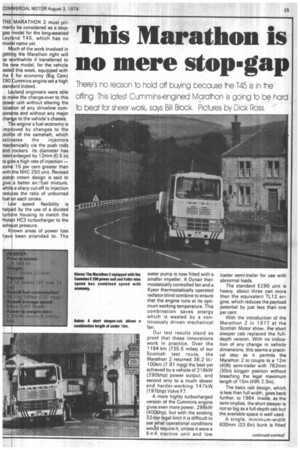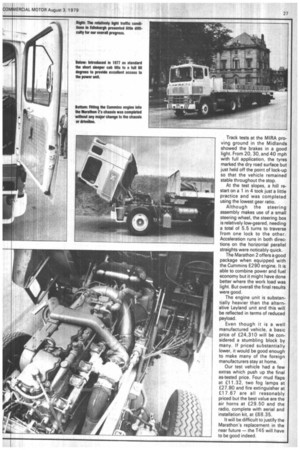This Marathon is no mere stop-gap:
Page 27

Page 28

Page 29

If you've noticed an error in this article please click here to report it so we can fix it.
There's no reason to hold off buying because ne 145 is in ne offing. This latest Cummins-engined Mara-on is going to be hard to beat for sheer work, says Bill Brock. Pictures by Dick Ross.
THE MARATHON 2 must primani y be considered as a stopgap odel for the long-awaited Leyl nd T45, which has no mod I name yet.
uch of the work involved in getti g the Marathon right will De orthwhile if transferred to he ew model, for the vehicle :este this week, equipped with he for economy (Big Cam) 290 ummins engine set a high gen ard indeed.
yland engineers were able to ni ke the change-over to this pow r unit without altering the loca ion of any driveline cornpon nts and without any major Pha e to the vehicle's chassis. e engine's fuel economy is mp oved by changes to the profi e of the camshaft, which 3Cti ates the injectors inec anically via the push rods and rockers. Its diameter has bee enlarged by 12mm (0.5 in) tog' e a high rate of injection — ;om 15 per cent greater than vvith he NHC 250 unit. Revised pist n crown design is said to give a better air/fuel mixture, II a sharp cut-off to injection redu es the ratio of unburned fuel n each stroke.
w speed flexibility is help d by the use of a divided turb ne housing to match the Ho Is t HC3 turbocharger to the exha st pressure.
own areas of power loss hay been attended to. The water pump is now fitted with a smaller impeller. A Dynair thermostatically controlled fan and a Kysor thermostatically operated radiator blind combine to ensure that the engine runs at its optimum working temperature. This combination saves energy which is wasted by a continuously driven mechanical fan.
Our test results stand as proof that these innovations work in practice. Over the 1184 km (735.5 miles) of our Scottish test route, the Marathon 2 returned 36.2 lit/ 100km (7.81 mpg) the best yet achieved by a vehicle of 216kW (290bhp) power output, and second only to a much slower and harder-working 147kVI/ (197bhp) Volvo F7.
A more highly turbocharged version of the Cummins engine gives even more power, 298kW (400bhp), but with the existing 32-ton legal limit it is difficult to see what operational conditions wou/ld require it, unless it were a 6 X 4 tractive unit and low
loader semi-trailer for use with abnOrmal loads.
The standard E290 unit is heavy, about three cwt more than the equivalent TL12 engine, which reduces the payload potential by just less than one per cent.
With the introduction of the Marathon 2 in 1977 at the Scottish Motor show, the short sleeper cab replaced the fulldepth version. With no indication of any change in vehicle dimensions, this seems a practical step as it permits the Marathon 2 to couple to a 12m (40ft) semi-trailer with 762mm (30in) kingpin position without breaching the legal maximum length of 15m (49ft 2.5in).
The basic cab design, which is less than full width, goes back. further, to 1964. Inside, as the term implies, the short sleeper is not so big as a full-depth cab but the available space is well used.
A single, minimum-width 600mm (23.6in) bunk is fitted 'behind the seat with a second, folding one, available as an option. The seats are covered in a brushed nylon material and while both are adjustable, the driver's has the advantage of its own suspension mechanism adjustable to suit one's individual weight.
Added ventilation to the cab's fresh air/heater system is provided by a five-position roof hatch. Tan and mid-brown trim includes acoustic panels in the roof lining and to the rear. The cab's high mounting position has several advantages. It allows some space between the underside and the cylinder head so that engine noise dissipates before reaching the shell.
Sound-absorbing material in the floor area reduces cab noise further still and so it is reasonably quiet. The engine cover can be kept lower, giving the illusion of more space inside, and forward vision is good. In consequence, access to the driver's seat suffers, but this effect is minimised by well placed steps, grab-handles for both hands and a door which opens to 90 degrees.
Simple lines of the vinylcovered facia extend full-width to include a flush-mounted well-equipped instrument panel housing tachometer, tachograph, oil, air and temperature gauges, plus a strip of warning lights. An audible warning device indicates low air and low engine oil pressure. Cab tilt is indicated by a warning light.
In the interest of improving the ride, the rear spring attachments for the drive axle have been changed to shackle fixings since ow last test of this model.
Starting the road section just south of Hinckley on the A5 gave me ample opportunity to get accustomed to the vehicle before encountering the first section of motorway. The Fuller rangechange gearbox had a short but precise movement. Maximum
engine torque at 1300rpm allows gearchanges as low as. '1000rpm before the vehicle began to labour, while at the top end, maximum power at 1900rpm gave a wide usable rev band.
A small 457mm (18in) steering wheel, backed by power assistance, did not require any more effort from the driver than is normally expected with this size of vehicle but initially there was some tendency to over-correct. By the start of the second day I had settled in and it no longer presented a problem.
Cruising at 60 mph was interrupted by the steeper inclines which alone demanded a reduction in gearing. Later where the legal limit was reduced to 40 mph, the use of top gear was still practical but allowed less margin for miscalculation.
Adequate engine power, high torque at low revs and a gearbox with few vices made light work of the toughest section of the road, from Rochester to Neville's Cross where 1 in 10
gradients are not uncommo and some are as bad as 1 in 7.
Fuel consumption over thi section was particularly gooc though later on the flat Al sec tion we might have expecte better.
In retrospect this Cummin engine performs best where has to work. On low-speed levi road running, little effort needed to maintain a fair spee and I suspect that a larger pri portion of the fuel pumped ml the cylinders remains unburr under these conditions and therefore wasted.
The ride is good but, eithE due to the seat or suspensior there was just a hint of shuntin back and forth. But drivin never became arduous and fa: journey times were enjoye without undue strain.
The instrument panel wa clear and controls were we placed. I found the exhaw
• brake gave a good resistance 1 the overrun on long downhi inclines. Activated by a he, movement on the throttle peda a firm pressure locks the devic on until the next application the throttle, leaving the rigl foot free to apply the main se vice brake as required.
Track tests at the MIRA proving ground in the Midlands showed the brakes in a good light. From 20, 30, and 40 mph with full application, the tyres marked the dry road surface but just held off the point of lock-up so that the vehicle remained stable throughout the stop.
At the test slopes, a hill restart on a 1 in 4 took just a little practice and was completed using the lowest gear ratio.
Although the steering assembly makes use of a small steering wheel, the steering box is relatively low-geared, needing a total of 5.5 turns to traverse from one lock to the other. Acceleration runs in both directions on the horizontal parallel straights were noticably quick.
The Marathon 2 offers a good package when equipped with the Cummins E290 engine. It is able to combine power and fuel economy but it might have done better where the work load was light. But overall the final results were good.
The engine unit is substantially heavier than the alternative Leyland unit and this will be reflected in terms of reduced payload.
Even though it is a well manufactured vehicle, a basic price of £24,310 will be considered a stumbling block by many. If priced substantially lower, it would be good enough to make many of the foreign manufacturers stay at home.
Our test vehicle had a few extras which push up the final as-tested price. Four mud flaps at i21 1.32, two fog lamps at £27.80 and fire extinguisher at £17.67 are all reasonably priced but the best value are the air horns at £29.50 and the radio, complete with aerial and installation kit, at £68.35.
It will be difficult to justify the Marathon's replacement in the near future — the T45 will have to be good indeed.




































































































